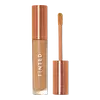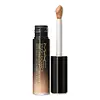Live Tinted Hueskin Serum Concealer Versus Mac Cosmetics Studio Radiance 24Hr Luminous Lift Concealer
What's inside
What's inside
 Key Ingredients
Key Ingredients

 Benefits
Benefits

 Concerns
Concerns

No concerns
 Ingredients Side-by-side
Ingredients Side-by-side

Water
Skin ConditioningShea Butter Ethyl Esters
EmollientPolyglyceryl-6 Pentaoleate
EmulsifyingIsoamyl Laurate
EmollientUndecane
EmollientGlycerin
HumectantDisteardimonium Hectorite
StabilisingCaprylic/Capric Triglyceride
MaskingTridecane
PerfumingJojoba Esters
EmollientMagnesium Sulfate
Niacinamide
SmoothingCaffeine
Skin ConditioningBakuchiol
AntimicrobialSodium Hyaluronate
HumectantSodium Hyaluronate Crosspolymer
HumectantHyaluronic Acid
HumectantHydrolyzed Hyaluronic Acid
HumectantAcacia Decurrens Flower Wax
EmollientAscorbyl Tetraisopalmitate
AntioxidantTocopherol
AntioxidantRaspberry Ketone
MaskingPersea Gratissima Oil
Skin ConditioningHelianthus Annuus Seed Wax
Skin ConditioningPhenoxyethanol
PreservativePropylene Carbonate
SolventGlycolipids
Skin ConditioningEthylhexylglycerin
Skin ConditioningPolyglycerin-3
HumectantPropanediol
SolventHydrolyzed Glycosaminoglycans
HumectantBenzyl Glycol
SolventCitric Acid
BufferingCI 77492
Cosmetic ColorantCI 77491
Cosmetic ColorantCI 77499
Cosmetic ColorantWater, Shea Butter Ethyl Esters, Polyglyceryl-6 Pentaoleate, Isoamyl Laurate, Undecane, Glycerin, Disteardimonium Hectorite, Caprylic/Capric Triglyceride, Tridecane, Jojoba Esters, Magnesium Sulfate, Niacinamide, Caffeine, Bakuchiol, Sodium Hyaluronate, Sodium Hyaluronate Crosspolymer, Hyaluronic Acid, Hydrolyzed Hyaluronic Acid, Acacia Decurrens Flower Wax, Ascorbyl Tetraisopalmitate, Tocopherol, Raspberry Ketone, Persea Gratissima Oil, Helianthus Annuus Seed Wax, Phenoxyethanol, Propylene Carbonate, Glycolipids, Ethylhexylglycerin, Polyglycerin-3, Propanediol, Hydrolyzed Glycosaminoglycans, Benzyl Glycol, Citric Acid, CI 77492, CI 77491, CI 77499
Water
Skin ConditioningPhenyl Trimethicone
Skin ConditioningTrimethylsiloxysilicate
EmollientMethyl Trimethicone
Skin ConditioningGlycerin
HumectantC9-12 Alkane
SolventNiacinamide
SmoothingButylene Glycol
HumectantNeopentyl Glycol Diheptanoate
EmollientAscorbyl Glucoside
AntioxidantLauryl PEG-9 Polydimethylsiloxyethyl Dimethicone
Skin ConditioningSilica
AbrasiveOlea Europaea Fruit Oil
MaskingSimmondsia Chinensis Seed Oil
EmollientHydrogenated Polyisobutene
EmollientPolysilicone-11
Hydroxyethyl Urea
HumectantAlgae Extract
EmollientTocopheryl Acetate
AntioxidantSodium PCA
HumectantHelianthus Annuus Seed Extract
Skin ConditioningCaffeine
Skin ConditioningSodium Hyaluronate
HumectantHordeum Vulgare Extract
EmollientTrametes Versicolor Extract
Cucumis Sativus Fruit Extract
EmollientPEG-10 Dimethicone
Skin ConditioningPropylene Glycol Dicaprate
EmollientSorbitol
HumectantCaprylyl Glycol
EmollientTrehalose
HumectantTriethyl Citrate
MaskingDipotassium Glycyrrhizate
HumectantSalicylic Acid
MaskingSodium Chloride
MaskingVinyl Dimethicone/Methicone Silsesquioxane Crosspolymer
Triethoxycaprylylsilane
Disteardimonium Hectorite
StabilisingAmmonium Acryloyldimethyltaurate/Vp Copolymer
Dimethicone/PEG-10/15 Crosspolymer
Alumina
AbrasiveLecithin
EmollientZinc Stearate
Cosmetic ColorantPropylene Glycol Caprylate
Skin ConditioningSodium Hydroxide
BufferingSodium Citrate
BufferingLaureth-7
EmulsifyingSynthetic Fluorphlogopite
Magnesium Aluminum Silicate
AbsorbentHexylene Glycol
EmulsifyingDisodium EDTA
Citric Acid
BufferingDipropylene Glycol
HumectantTin Oxide
AbrasiveResveratrol
AntioxidantPhenoxyethanol
PreservativePotassium Sorbate
PreservativeCI 77891
Cosmetic ColorantCI 77492
Cosmetic ColorantCI 77491
Cosmetic ColorantCI 77499
Cosmetic ColorantWater, Phenyl Trimethicone, Trimethylsiloxysilicate, Methyl Trimethicone, Glycerin, C9-12 Alkane, Niacinamide, Butylene Glycol, Neopentyl Glycol Diheptanoate, Ascorbyl Glucoside, Lauryl PEG-9 Polydimethylsiloxyethyl Dimethicone, Silica, Olea Europaea Fruit Oil, Simmondsia Chinensis Seed Oil, Hydrogenated Polyisobutene, Polysilicone-11, Hydroxyethyl Urea, Algae Extract, Tocopheryl Acetate, Sodium PCA, Helianthus Annuus Seed Extract, Caffeine, Sodium Hyaluronate, Hordeum Vulgare Extract, Trametes Versicolor Extract, Cucumis Sativus Fruit Extract, PEG-10 Dimethicone, Propylene Glycol Dicaprate, Sorbitol, Caprylyl Glycol, Trehalose, Triethyl Citrate, Dipotassium Glycyrrhizate, Salicylic Acid, Sodium Chloride, Vinyl Dimethicone/Methicone Silsesquioxane Crosspolymer, Triethoxycaprylylsilane, Disteardimonium Hectorite, Ammonium Acryloyldimethyltaurate/Vp Copolymer, Dimethicone/PEG-10/15 Crosspolymer, Alumina, Lecithin, Zinc Stearate, Propylene Glycol Caprylate, Sodium Hydroxide, Sodium Citrate, Laureth-7, Synthetic Fluorphlogopite, Magnesium Aluminum Silicate, Hexylene Glycol, Disodium EDTA, Citric Acid, Dipropylene Glycol, Tin Oxide, Resveratrol, Phenoxyethanol, Potassium Sorbate, CI 77891, CI 77492, CI 77491, CI 77499
Ingredients Explained
These ingredients are found in both products.
Ingredients higher up in an ingredient list are typically present in a larger amount.
Caffeine is most associated with coffee, tea, and cacao. In skincare, it helps with calming inflammation and is rich in antioxidants.
While caffeine is used to treat cellulite and and dark circles, further studies are needed to prove this. It has been believed to help with these skin conditions due to its ability to dilate blood vessels and increase blood flow.
Some studies are looking into caffeine's ability to protect against UV rays.
Learn more about CaffeineCi 77491 is also hydrated iron III oxide. It's sole purpose is to give a red/pink hue to products.
Iron III oxides are classified as inorganic chemicals for coloring.
Synthetically created Ci 77491 is considered safer than those naturally found. This is because the synthetically created version may contain less impurities. Iron oxides are generally non-toxic and non-allergenic.
Learn more about CI 77491Ci 77492 is also hydrated iron III oxide. It's sole purpose is to give a yellow hue to products.
Iron III oxides are classified as inorganic chemicals for coloring.
Synthetically created Ci 77492 is considered safer than those naturally found. This is because the synthetically created version may contain less impurities. Iron oxides are generally non-toxic and non-allergenic.
Learn more about CI 77492Ci 77499 is also hydrated iron III oxide. It is created from mixing red and black iron oxides. This helps give shades of darkness to a product.
Iron III oxides are classified as inorganic chemicals for coloring.
Citric Acid is an alpha hydroxy acid (AHA) naturally found in citrus fruits like oranges, lemons, and limes.
Like other AHAs, citric acid can exfoliate skin by breaking down the bonds that hold dead skin cells together. This helps reveal smoother and brighter skin underneath.
However, this exfoliating effect only happens at high concentrations (20%) which can be hard to find in cosmetic products.
Due to this, citric acid is usually included in small amounts as a pH adjuster. This helps keep products slightly more acidic and compatible with skin's natural pH.
In skincare formulas, citric acid can:
While it can provide some skin benefits, research shows lactic acid and glycolic acid are generally more effective and less irritating exfoliants.
Most citric acid used in skincare today is made by fermenting sugars (usually from molasses). This synthetic version is identical to the natural citrus form but easier to stabilize and use in formulations.
Read more about some other popular AHA's here:
Learn more about Citric AcidDisteardimonium Hectorite comes from the clay mineral named hectorite. It is used to add thickness to a product.
It can also help stabilize a product by helping to disperse other ingredients.
Hectorite is a rare, white clay mineral.
Learn more about Disteardimonium HectoriteGlycerin is already naturally found in your skin. It helps moisturize and protect your skin.
A study from 2016 found glycerin to be more effective as a humectant than AHAs and hyaluronic acid.
As a humectant, it helps the skin stay hydrated by pulling moisture to your skin. The low molecular weight of glycerin allows it to pull moisture into the deeper layers of your skin.
Hydrated skin improves your skin barrier; Your skin barrier helps protect against irritants and bacteria.
Glycerin has also been found to have antimicrobial and antiviral properties. Due to these properties, glycerin is often used in wound and burn treatments.
In cosmetics, glycerin is usually derived from plants such as soybean or palm. However, it can also be sourced from animals, such as tallow or animal fat.
This ingredient is organic, colorless, odorless, and non-toxic.
Glycerin is the name for this ingredient in American English. British English uses Glycerol/Glycerine.
Learn more about GlycerinNiacinamide is a multitasking form of vitamin B3 that strengthens the skin barrier, reduces pores and dark spots, regulates oil, and improves signs of aging.
And the best part? It's gentle and well-tolerated by most skin types, including sensitive and reactive skin.
You might have heard of "niacin flush", or the reddening of skin that causes itchiness. Niacinamide has not been found to cause this.
In very rare cases, some individuals may not be able to tolerate niacinamide at all or experience an allergic reaction to it.
If you are experiencing flaking, irritation, and dryness with this ingredient, be sure to double check all your products as this ingredient can be found in all categories of skincare.
When incorporating niacinamide into your routine, look out for concentration amounts. Typically, 5% niacinamide provides benefits such as fading dark spots. However, if you have sensitive skin, it is better to begin with a smaller concentration.
When you apply niacinamide to your skin, your body converts it into nicotinamide adenine dinucleotide (NAD). NAD is an essential coenzyme that is already found in your cells as "fuel" and powers countless biological processes.
In your skin, NAD helps repair cell damage, produce new healthy cells, support collagen production, strengthen the skin barrier, and fight environmental stressors (like UV and pollution).
Our natural NAD levels start to decline with age, leading to slower skin repair, visible aging, and a weaker skin barrier. By providing your skin niacinamide, you're recharging your skin's NAD levels. This leads to stronger, healthier, and younger looking skin.
Another name for vitamin B3 is nicotinamide. This vitamin is water-soluble and our bodies don't store it. We obtain Vitamin B3 from either food or skincare. Meat, fish, wheat, yeast, and leafy greens contain vitamin B3.
The type of niacinamide used in skincare is synthetically created.
Learn more about NiacinamidePhenoxyethanol is a preservative that has germicide, antimicrobial, and aromatic properties. Studies show that phenoxyethanol can prevent microbial growth. By itself, it has a scent that is similar to that of a rose.
It's often used in formulations along with Caprylyl Glycol to preserve the shelf life of products.
Sodium Hyaluronate is hyaluronic acid's salt form. It is commonly derived from the sodium salt of hyaluronic acid.
Like hyaluronic acid, it is great at holding water and acts as a humectant. This makes it a great skin hydrating ingredient.
Sodium Hyaluronate is naturally occurring in our bodies and is mostly found in eye fluid and joints.
These are some other common types of Hyaluronic Acid:
Learn more about Sodium HyaluronateWater. It's the most common cosmetic ingredient of all. You'll usually see it at the top of ingredient lists, meaning that it makes up the largest part of the product.
So why is it so popular? Water most often acts as a solvent - this means that it helps dissolve other ingredients into the formulation.
You'll also recognize water as that liquid we all need to stay alive. If you see this, drink a glass of water. Stay hydrated!
Learn more about Water